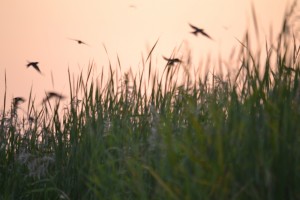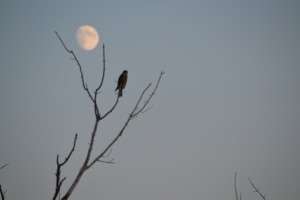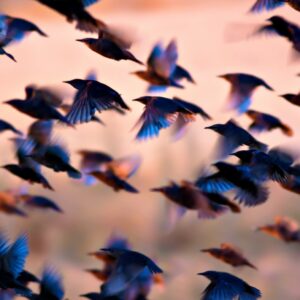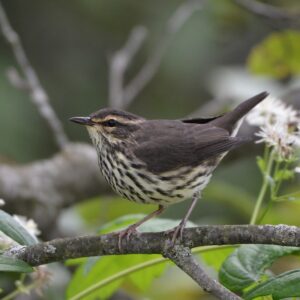A chance encounter leads to a guided tour of a Manitoba Important Bird Area
[two_third]Charlie McPherson, Important Bird Area Caretaker for the Netley-Libau Marsh in Manitoba, shares his story of the extraordinary sights he witnessed on a recent birding trip.
In August, I attended a fundraiser for The Lake Winnipeg Foundation.. I met a scientist, Buster Welch, at the fundraiser who’s on one of the Foundation’s boards who just so happens to have a boat. When he heard I was Caretaking and birding our Important Bird Area – the Netley-Libau Marsh, he offered the boat to me for as long as, and for as many times as, I would need it. When I said, “I have a boat,” he said, “Ah, but mine is in the water.” How true!
The Netley-Libau marsh, Important Bird Area (IBA) 009, is about 18 square kilometres in size and flows into Lake Winnipeg. It is an entire ecosystem in upheaval. The Lake Winnipeg Regulation (a dam in the north) keeps it submerged. A submerged marsh is a dying marsh. I live at the northwest corner of this marsh. The scientist lives at the southwest corner. For me to bird the southwest corner, it means hooking up my boat and trailer and launching in Lake Winnipeg nearby (usually quite possible if wind and weather conditions are right, and in the summer they usually are) and a long journey south through the marsh’s maze of channels to the southwest corner, or it could mean a simple little hop, skip and a straight jump by road to his boat in the southwest corner – no loading and/or launching of anything – just jump in.
He offered to tour me through Wheeler’s Lake too, the only marsh lake I hadn’t done bird counts in throughout the spring and summer. It’s in the crown lands off the marsh’s vast interior and is not as affected by lake regulation. It’s a small, shallow delta marsh lake at the end of Wavy Creek which drains into Netley Creek, which drains into the Red River, which drains into the Netley-Libau marsh – all of the above being a part of the IBA.
After setting out together and entering the IBA, we found Green Herons (rare for this area) in one of the fingernail ponds at the end of a water finger within Wheeler’s Lake that evening and a few grebes, ducks, other herons, coots and shorebirds etc. – the shallow, weedy, fingertip ponds being where a lot of the life of the marsh is. A Great Egret (another rare bird for this marsh/area) was sighted just last week, and I found 8 earlier in the season in the Crooked Creek area (northeast corner of the marsh).
I call the last hour before dusk the ‘Magic Hour’. It’s the hour before the birds settle in for the night, the hour when all kinds of bird activity is going on. Ring-billed Gulls, for example, concentrate in this marsh before heading south and there were thousands flying back in from the surrounding farm lands that evening – thousands. I thought I’d be counting them forever when a few Barn Swallows started showing up. I’ve read that Barn Swallows will almost exclusively roost in marshes during migration, and on their wintering grounds. When my scientist guide shouted, “Tree Swallows!” I looked up and saw that they were Barn Swallows and said so.
They WERE Barn Swallows and their numbers built from a few, to a dozen, to a couple dozen or more as we boated through a quarter mile diameter of creek opening in a sea of cattails where Wheeler’s Lake meets Netley Creek. I didn’t think much about it at first but fall migrating swallow concentrations are a part of why this area is designated an Important Bird Area. You don’t see too many swallows zipping around the marsh throughout the summer breeding season so when they started showing up in the dozens I thought it better to be counting them rather than Ring-billed Gulls, so I dropped counting the individual gulls on this trip and just gave them a ‘guestimate’, a rough approximation of the actual numbers.
As we quietly motored into Netley Creek, the creek suddenly turned into a turmoil of golf-ball sized splashes, what we thought at first were feeding fish. We both like to fish so we were quite interested in what was going on and, upon examination, realized it was the Barn Swallows returning to the marsh in mass from wherever it was that they had been during the day, diving in for a quick dip and a probable drink, an immediate out, and then into the cattails to preen. (I’ve watched Red-eyed Vireos do the quick dip thing, as well, although not in mass).
There’s no way to count a big bunch of Barn Swallows cruising around like WW2 fighter bombers. They were everywhere! Truly, this was a birding experience EXTRA-ORDINAIRE! Golf ball-sized Barn Swallows! Imagine that! Thank you IBA program! I might have missed that had I not been in the marsh doing these counts. I gave them a guestimate, too, like I did the Ring-billed Gulls. I hope to run into them again on another count. That might help to nail down some of their numbers.
I truly appreciated being guided through Wheeler’s Lake, not just because of the Green Heron and Barn Swallow experiences, but because Buster was sensitive as to how he maneuvered his boat, how he got me up close to the birds, and how he held the boat in the breezes. On the way back out, with a spectacular red sun setting in the west and a rising white moon in the east, we came across and passed a Merlin perched in a small, dead maple tree. My guide turned the boat gently back downstream, re-approached the Merlin (which kindly obliged us by not flying off) and positioned it in such a way that I could photograph the Merlin with the moon hovering over it, moon framed by branches – another wonderful birding experience. There is no doubt in my mind that the Merlin had been preying upon the swallows and the hundreds, and hundreds, and hundreds of blackbirds coming in from the surrounding areas to roost in the marsh that night – fall concentrations of blackbirds are another reason this IBA is an IBA.
[/two_third] [one_third_last]
 Barn swallows by Charlie McPherson
Barn swallows by Charlie McPherson
 Merlin photographed at sunset by Charlie McPherson.
Merlin photographed at sunset by Charlie McPherson.
[/one_third_last]



